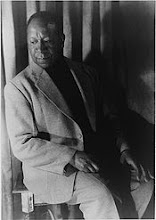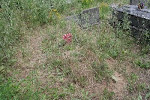On December 14, Les Amis de Beauford Delaney will celebrate sixteen years of honoring Beauford's brilliance through the Les Amis blog.
This anniversary is important because it marks a major transition in the life of the blog, which has grown into both a beloved source of stories for casual readers and a valuable reference for scholars wishing to explore Beauford’s life and art.
To honor this journey and better serve our worldwide community, we are bringing Les Amis into a new era.
We’re working on a major upgrade: moving the blog (which has approximately 750 posts to date) to a modern platform that will improve accessibility, allow interactive features, and safeguard our content for the future.
This platform will be hosted by the Wells International Foundation (WIF).
WIF is the U.S. nonprofit that raised the money for and organized the Resonance of Form and Vibration of Color exhibition, which launched Beauford's renaissance in 2016.*
Resonance of Form and Vibration of Color catalog cover
Great progress has been made on this project, and as of this writing, we are on track to complete the transition by the end of December 2025.
Once this has been accomplished, we will perform a final series of tests for functionality and go live early in 2026.
Today, we want to reflect on and celebrate what has transpired since our first post on December 14, 2009.
How It All Began
Les Amis de Beauford Delaney is a small, French non-profit organization (Association 1901) that was created in November 2009.
Beauford Delaney
(1953) Carl Van Vechten
The goals of the organization are as follows:
1) Placement and maintenance of a tombstone for the grave of painter Beauford Delaney, who is buried at the Parisian Cemetery of Thiais
2) Payment of the renewal fees for his grave
3) Organization of commemorative or educational events in his honor
4) Informing the press and the media of his life and accomplishments.
For several years, the French nonprofit pursued all four goals on its own.
We launched the blog to raise awareness of Beauford's story in support of the fundraising effort to place a tombstone at his previously unmarked grave at Thiais Cemetery outside of Paris.
With the support of the U.S. Embassy and numerous private donors, we succeeded in this effort and laid the stone over the summer of 2010.
We organized a graveside ceremony, which was followed by a U.S. Embassy-hosted reception in Paris on October 14, 2010.
Gathering around the tombstone
© Discover Paris!
Because of the passion ignited by this effort, we continued to delve into his life and art and bring these stories to the public through the blog.
Beginning with the 2016 Resonance of Form exhibition, we have partnered with WIF on various events.
When the blog is transferred to the new platform, we will work with WIF in an advisory capacity on the selection of content that will be uploaded alongside the blog.
We are excited that what started as a modest online publication has grown into a key resource supporting the global renaissance of interest in Beauford’s work.
Sixteen Years of Milestones and Achievements
Across these sixteen years, Les Amis has supported and documented major developments in the reclamation and expansion of Beauford’s artistic legacy.
We have
- Featured exhibitions of his work around the world and highlighted new acquisitions of his works by major museums
- Reported on the sale of his work by numerous auction houses and celebrated record breaking transactions
- Shared anecdotes from personal friends and acquaintances that shed light on Beauford's personal life
- Documented initiatives to preserve Beauford Delaney archival materials
- Exposed readers to the vast depth and breadth of his artistic practice
- Provided support for scholars wanting to investigate his life and work as well as the life and work of his famous mentee, James Baldwin.
Beauford's work at the groundbreaking Paris Noir exhibition in 2025
© Entrée to Black Paris
Negro Man [Claude McKay]
(1944) Oil on canvas
Acquired by the Los Angeles County Museum of Art in 2022
© Estate of Beauford Delaney,
by permission of Derek L. Spratley, Esquire,
Court Appointed Administrator,
Image: Michael Rosenfeld Gallery LLC, New York, NY
 The Sage Black
The Sage Black
(1967) Oil on canvas
Record-breaking sale by Christie's in November 2025
$1.2 million (hammer price)
© Estate of Beauford Delaney
by permission of Derek L. Spratley, Esquire,
Court Appointed Administrator
Courtesy of Michael Rosenfeld Gallery, LLC, New York, NY
Through these efforts, Les Amis has played a significant role in shifting Beauford from the margins to the center of conversations on 20th century artists.
Moments That Resonated the Most
Among the many posts that have filled the blog over the years, certain stories have left an enduring mark.
These include profiles and posts about
- Beauford’s friendships, particularly his life-changing bond with James Baldwin
- Projects inspired by Beauford's life and work, including the Classes Duo partnership with the City of Paris and the play, Amazing Grace is Yellow
- Lesser-known moments of Beauford's life in Knoxville and Boston
- Deep dives into specific paintings that helped newcomers connect emotionally with his work
- Scholarly commentary and exchanges about Beauford's œuvre.

These posts remind us that the blog is more than an archive—it is a space for discovery, memory, conversation, and connection.
The Community That Keeps the Blog Alive
We cannot honor this milestone anniversary without recognizing the vibrant community that has sustained this project:
- The readers who come back year after year
- The students and scholars who find information and images to support their work on the blog
- The educators who use our posts in their classrooms
- The friends of Beauford who read the blog and are inspired to contribute their own stories about him
- The museum curators, auction houses, and archivists who share research or request information.
Speculative Light book cover
Cover Art: Portrait of James Baldwin
(1965) Oil on canvas
Chrysler Museum of Art, Norfolk, VA
© Estate of Beauford Delaney
by permission of Derek L. Spratley, Esquire
Court Appointed Administrator
Courtesy of Michael Rosenfeld Gallery LLC, New York, NY
We especially thank the Estate of Beauford Delaney, the Knoxville Museum of Art, Galerie Intemporel, the Beck Cultural Exchange Center, the University of Arizona, the University of Tennessee Knoxville, and the Michael Rosenfeld Gallery for their unwavering support over the lifetime of the blog.
Looking Forward
Sixteen years is a milestone, but it is also a beginning. We continue to work—joyfully and intentionally—to expand Beauford's legacy.
Because Beauford deserves more ...
... more recognition, more scholarship, and more space in the global conversation about modern art.
Looking ahead, Les Amis aims to
- Launch new digital features, examples of which include exclusive interviews, digital stories, and curated reading lists.
- Expand access to resources for students, educators, and Black and other cultural institutions.
- Support new research that deepens our understanding of Beauford’s artistic evolution.
- Continue collaborating with museums and scholars on exhibitions and archival projects.
- Continue nurturing the community of Beauford's supporters around the world.
Our overarching mission remains the same: to keep the light shining brightly on Beauford’s work and to ensure his story is never again pushed to the edges of art history.
In Gratitude
To everyone who has walked this sixteen-year journey with us—thank you!
Your curiosity, your engagement, your passion, and your love for Beauford’s art make this blog a living tribute.
His legacy continues because you choose to be part of keeping it alive.
Auto-portrait
(1965) Oil on canvas
Whitney Museum of American Art, New York City
© Estate of Beauford Delaney
by permission of Derek L. Spratley, Esquire,
Court Appointed Administrator
Courtesy of Michael Rosenfeld Gallery LLC, New York, NY
*****************
*WIF is raising $3200 to support the cost of transitioning the Les Amis blog to its new home.
If you'd like to donate, click HERE to access WIF's giving page.
Enter "Beauford Delaney" in the donor note so your gift is directed to this project.





















































